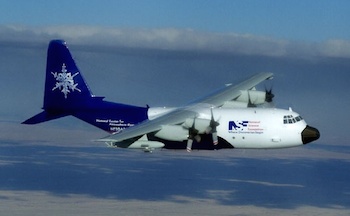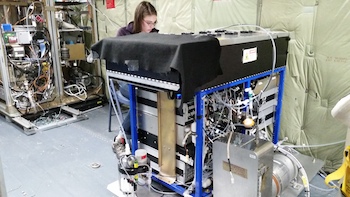2015 News & Events
Investigating How Air Pollution Forms in the Winter
16 January 2015

Later this month, scientists from the Earth System Research Laboratory (ESRL) Chemical Sciences Division (CSD) will join colleagues from the National Center for Atmospheric Research (NCAR) and several universities in an airborne atmospheric chemistry campaign to understand pollution in the wintertime: the aptly named Wintertime Investigation of Transport, Emissions, and Reactivity (WINTER 2015).
The timing of the mission (winter) might at first glance be puzzling. After all, "prime time" for pollution is summer, when increased sunlight and temperatures boost the primary pollutants and precursors emitted directly by some sources, and speed up chemical reactions that transform precursors into other "secondary" pollutants. But pollution doesn't cease at summer's end – instead, its pathways to the familiar summertime pollutants (ozone, particulate matter, and others) are altered, in ways that have not been well studied and that therefore are not well understood.

WINTER 2015 aims to remedy this gap in understanding, through a 6-week field campaign in the Northeast U.S. to make airborne measurements of the host of trace gases and particles in the air. From February 1 to March 15, scientists will use the NSF/NCAR C-130 research aircraft based at NASA Langley in Hampton, VA, to sample several kinds of pollution sources in the mid-Atlantic and southeastern U.S.: large urban areas, coal-fired power plants, oil and gas extraction fields, agricultural or biofuel burning, and vegetation.
The project has three goals:
- to characterize the chemical transformations of wintertime emissions with an equal focus on nocturnal and multiphase processes (which should dominate in winter) as on photochemistry (which is more characteristic of summer);
- to assess the dominant mechanism that forms secondary "aerosol" (atmospheric fine particles), and quantify the geographical distribution of inorganic and organic aerosol types during winter; and
- to provide constraints on wintertime emission inventories for urban areas, power plants and agricultural areas, and characterize the export pathways of primary pollutants to the North Atlantic.

CSD scientist Steve Brown along with Joel Thornton (University of Washington), Jose Jimenez (University of Colorado and CIRES), and several other university colleagues are the WINTER Principal Investigators. Steve and Joel will share flight scientist duties which include developing daily flight plans and working on board during a flight with the pilots and instrument scientists to achieve flight objectives. CSD will operate three instruments on board the C-130 to measure a suite of nitrogen-containing trace gases, ozone, sulfur dioxide, and organic acids. Other investigators will be measuring several other trace gases as well as airborne particles, ultimately yielding a rich data set that will enable the researchers to decipher the wintertime chemical pathways that transform primary emissions (such as methane and nitrogen oxides) into secondary pollutants (such as ozone and fine particles).
Though the researchers expect to see some familiar processes at work in the wintertime, they also expect differences. The colder temperatures and reduced sunlight lead to a different mix of emissions (for example, as agricultural activities shift in wintertime and as biogenic emissions cease or are reduced), and also slow down the chemical transformations in the atmosphere. The slowed chemistry means that the drivers of pollution chemistry in summer (ozone photolysis and hydroxyl radicals) are only minor players in winter. Instead, different trace gases, such as nitryl chloride (ClNO2) and nitrous acid (HONO) almost certainly have larger, but unexplored, roles in wintertime pollution chemistry. In addition, the slowed chemistry means that emissions from all sources (such as cities and power plants) have more staying power in the atmosphere before they are removed by reactions. The pollutants' longer lifetime in the atmosphere enables them to spread to a broader region in winter compared with summer.
Ultimately, the findings from WINTER 2015 should help researchers better understand the impacts of wintertime processes on air quality and climate.
CSD scientists involved in the project are: Steve Brown (Principal Investigator), Patrick Veres (CIRES), Bill Dubé (CIRES), John Holloway (CIRES), Erin McDuffie (CIRES), Jim Roberts, and Dorothy Fibiger (NSF Geospace Sciences Post-Doctoral Fellow).